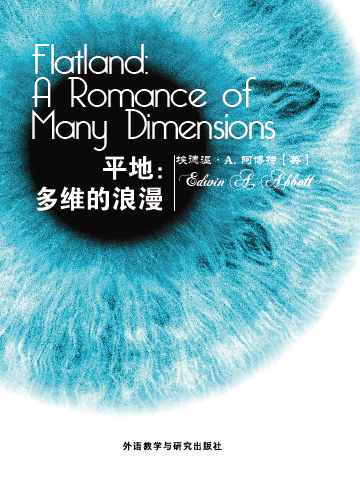I call our world Flatland, not because we call it so, but to make its nature clearer to you, my happy readers, who are privileged to live in Space.
Imagine a vast sheet of paper on which straight Lines, Triangles, Squares, Pentagons, Hexagons, and other figures, instead of remaining fixed in their places, move freely about, on or in the surface, but without the power of rising above or sinking below it, very much like shadows-only hard and with luminous edges-and you will then have a pretty correct notion of my country and countrymen. Alas, a few years ago, I should have said "my universe": but now my mind has been opened to higher views of things.
《平地:多维的浪漫》写于1884年,描述了一个二维世界,并探索了自然界中的维度。它常被归类为科幻小说,尽管它应被称为“数学科幻小说”。从20世纪50年代科幻小说出现至今,《平地》已迎来了再一次流行,尤其在科幻迷和网络庞克迷(cyberpunk fans)中间。它也启发了许多作品,包括它的续集和一部叫《二维世界》 (Flatland)的电影。
Flatland: A Romance of Many Dimensions is an 1884 satirical novella by the English schoolmaster Edwin Abbott Abbott. Writing pseudonymously as "A Square", the book used the fictional two-dimensional world of Flatland where class is determined by how many sides you possess to offer pointed observations on the social hierarchy of Victorian culture. However, the novella's more enduring contribution is its examination of dimensions. The book illuminates the social and intellectual context that produced the work as well as the timeless questions that it raises about the limits of our perception and knowledge.
- PART I: THIS WORLD—Section 1. Of the Nature of Flatland
- PART I: THIS WORLD—Section 2. Of the Climate and Houses in Flatland
- PART I: THIS WORLD—Section 3. Concerning the Inhabitants of Flatland
- PART I: THIS WORLD—Section 4. Concerning the Women
- PART I: THIS WORLD—Section 5. Of our Methods of Recognizing one another
- PART I: THIS WORLD—Section 6. Of Recognition by Sight
- PART I: THIS WORLD—Section 7. Concerning Irregular Figures
- PART I: THIS WORLD—Section 8. Of the Ancient Practice of Painting
- PART I: THIS WORLD—Section 9. Of the Universal Colour Bill
- #PART I: THIS WORLD—Section 10. Of the Suppression of the Chromatic Sedition
- PART I: THIS WORLD—Section 11. Concerning our Priests
- PART I: THIS WORLD—Section 12. Of the Doctrine of our Priests
- PART II: OTHER WORLDS—Section 13. How I had a Vision of Lineland
- PART II: OTHER WORLDS—Section 14. How I vainly tried to explain the nature of Flatland
- PART II: OTHER WORLDS—Section 15. Concerning a Stranger from Spaceland
- PART II: OTHER WORLDS—Section 16. How the Stranger vainly endeavoured to reveal to me in words the mysteries of Spaceland
- PART II: OTHER WORLDS—Section 17. How the Sphere, having in vain tried words, resorted to deeds
- PART II: OTHER WORLDS—Section 18. How I came to Spaceland, and what I saw there
- PART II: OTHER WORLDS—Section 19. How, though the Sphere shewed me other mysteries of Spaceland, I still desired more; and what came of it
- PART II: OTHER WORLDS—Section 20. How the Sphere encouraged me in a Vision
- PART II: OTHER WORLDS—Section 21. How I tried to teach the Theory of Three Dimensions to my Grandson, and with what success
- PART II: OTHER WORLDS—Section 22. How I then tried to diffuse the Theory of Three Dimensions by other means, and of the result
- 书评 写书评
- 笔记
-
书评加载中...












 京公网安备 11010802032529号
京公网安备 11010802032529号
笔记加载中...